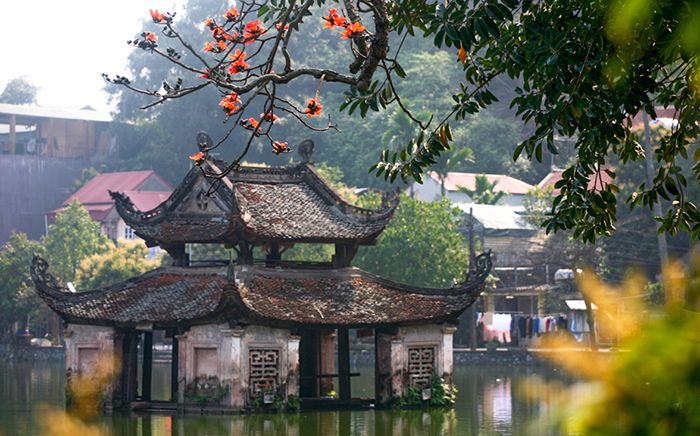Thầy Pagoda (originally named Thiên Phúc Tự) is one of the most ancient and famous pagodas in Hanoi. It is located at the foot of Sài Sơn Mountain, in Sài Sơn commune, Quốc Oai district, approximately 20 km southwest of central Hanoi. This is a popular spiritual tourism destination that attracts numerous visitors.
1. History and Associated Figure
The pagoda was built in the 11th century during the reign of King Lý Nhân Tông. It is closely associated with Zen Master Từ Đạo Hạnh (1072–1116), a renowned figure in the history of Vietnamese Buddhism. He was not only a monk but also the founder of the traditional water puppet art, as well as a physician and mystic. Legend has it that he reincarnated three times: as the Buddha, as the son of King Lý Nhân Tông (who later became King Lý Thần Tông), and as a monk who saved the king.
2. Unique Architecture
Thầy Pagoda features the distinctive architectural style of “front worships Buddha, back honors the Saint”—a rare trait that honors both Buddha and Zen Master Từ Đạo Hạnh. The main structure consists of three parallel buildings arranged in the shape of the Chinese character “Tam” (三), symbolizing the Three Jewels (Buddha – Dharma – Sangha):
- Lower Pagoda (Tiền Đường): A place for worship and Dharma lectures, housing statues of Deities and Saints.
- Middle Pagoda (Trung Điện): Dedicated to the Three Jewels, with statues of Buddha and Dharma Protectors on both sides.
- Upper Pagoda (Thượng Điện): Houses statues of Amitabha Trinity, Shakyamuni, and especially the three reincarnation forms of Từ Đạo Hạnh—as Monk, Buddha, and Emperor.
Two stone bridges, Nhật Tiên Kiều and Nguyệt Tiên Kiều, cross the Long Trì Lake, creating a harmonious landscape. At the center of the lake lies the Thủy Đình (Water Pavilion), where traditional water puppet performances are held—a unique aspect of Vietnamese folk art.
3. Landscape and Location
The pagoda is built following the feng shui principle of “sitting against the mountain, facing the water.” Long Trì Lake in front resembles a pearl, symbolizing the “dragon holding a gem” terrain. The surrounding natural caves enhance the sacred and mysterious atmosphere of the pagoda.
4. Thầy Pagoda Festival
The Thầy Pagoda Festival takes place annually from the 5th to 7th of the third lunar month to honor Zen Master Từ Đạo Hạnh. The festival features water puppet shows, ceremonial processions, and recitations of poems written by the Zen master and King Lý Nhân Tông.

